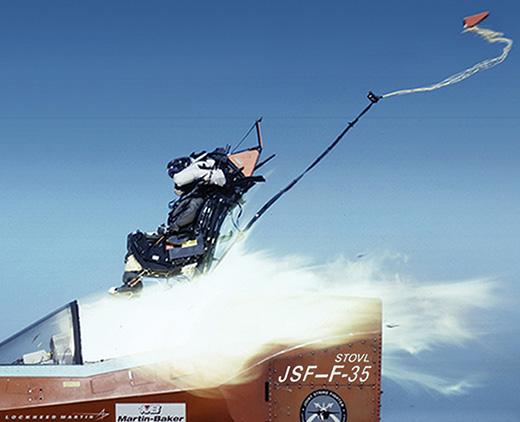Problems with the ejection seat of the F-35 will not be solved at least until the 2018. All current restrictions will remain in force for the next two years. This is what the Air Force officially communicates.
However, - add from the Joint Program Office - the resolution of this problem has absolute priority. Engineers are trying to reduce the weight of the helmet to prevent potentially lethal neck injuries for pilots being ejected from the aircraft.
The helmet problem was discovered last winter and since then all tests have been suspended for lighter riders. In fact, a pilot who weighs 60 pounds cannot wear the current 400 thousand dollar helmet. A pilot with a weight of 60 kilos (tolerance threshold in excess of and in default of two kilos), has a chance on 50.000 to suffer a neck injury in case of expulsion. Pilots who weigh between the 63 and the 74 kilos, have fewer risks with a chance on 200.000 of suffering a potentially fatal neck injury.
Then there is the question of the seat built by the British company Martin-Baker, where a "potentially fatal error for the life of the pilot" was found. This error already has a number of potential victims: one third of the pilots who will fly with the F-35. In the ejection phase, so we are in emergency conditions, the system would cause such a violent whiplash due to an incorrect position of the seat propelled outside the aircraft. The risk, recognized by the Department of Defense, is real for pilots between 60 and 65 chili. Tests have shown that pilots, whose weight is approaching just short of or in excess of the 135 / 140 pounds, have a probability of death equal to 98% during expulsions to 160 knots. For those who do not know it is the average speed of a take-off or landing.
The American pilots qualified with the F-35 that fall in this weight category are equal to 7%. Their rating has been suspended. But the problem may have been underestimated because the percentage of risk remains high even for pilots with an average weight.
"If the 2014 was the year of the engine, the 2015 was the year of the ejection seat".
 The Pentagon is working with Martin Baker and Lockheed Martin on three main fixes: designing a lighter helmet to reduce pressure on the pilot's neck, installing a system that will delay the deployment of the main parachute and mounting a support panel for the head between the parachute braces.
The Pentagon is working with Martin Baker and Lockheed Martin on three main fixes: designing a lighter helmet to reduce pressure on the pilot's neck, installing a system that will delay the deployment of the main parachute and mounting a support panel for the head between the parachute braces.
The three corrections were expected to be implemented by the summer of 2017. The Air Force, in an email from last 8 January, acknowledged that the corrections will be implemented by the 2018. Lockheed delivered 33 of the 340 F-35B purchased by the Marine Corps in addition to the 80 F-35C to be deployed on the aircraft carriers. The Marines have more than fifty pilots qualified for the F-35 and more than 400 military specialists in maintenance.
According to the Marine Corps Aviation Plan, the F-35 will replace the entire EA-6B fleet Prowler within the 2019 and will displace the AV-8B Harrier from the 2026. Finally, the F-35 will detect the F / A-18 Hornet in the 2030. The Air Force will reach the Initial Operative Capacity of the F-35A as soon as the first squad consisting of 12-24 aircraft will be formed, with trained aviators and crews able to perform close air support missions, interdiction and limited suppression and destruction of enemy anti-aircraft defenses.
The F-35A will reach the Initial Operational Capacity between August and December of the 2016. Finally, the US Navy, equipped with the F-35C, will reach the Initial Operational Capacity as soon as the first squadron of 10 aircraft will be formed, with personnel and pilots of the navy trained and able to carry out the assigned missions. The F-35C will reach the Initial Operational Capacity between August 2018 and February 2019.
The 55 years of life of the F-35 fighter will cost the United States 1500 billions of dollars. In addition to the United States, hunting was ordered by Great Britain, Australia, Italy, Turkey, Norway, the Netherlands, Japan, South Korea and Israel.
(photo: Martin Baker / Lockheed Martin)












